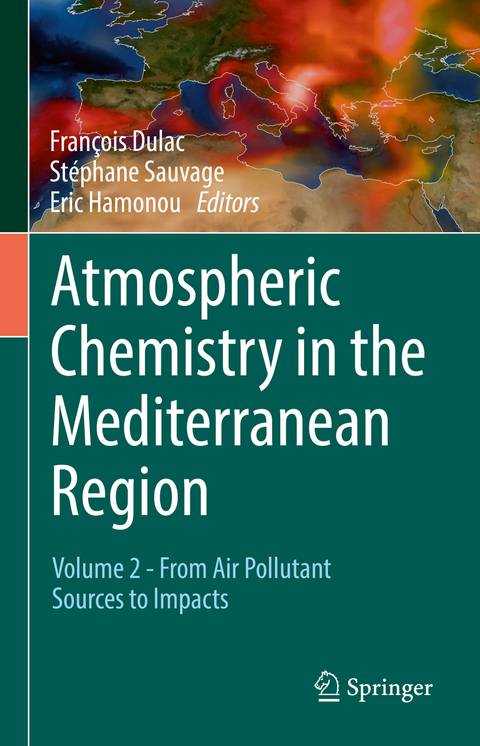
Atmospheric Chemistry in the Mediterranean Region
Springer International Publishing (Verlag)
978-3-030-82384-9 (ISBN)
This two-volume set provides an extensive review of the abundant past and recent literature on the atmospheric chemistry in the Mediterranean region. The books document the experience gained on the atmospheric composition over the Mediterranean basin and close areas after six decades of research, starting from early studies of radioactive aerosol fallouts and intense desert dust events in the 1960s, followed by studies of aerosols collected during oceanographic cruises in the early 1980s, and including subsequent knowledge from various surface monitoring stations, intensive campaigns, satellite climatologies, laboratory studies, as well as chemistry-transport and climate models. Through ten thematic sections, the authors examine the sources and fates of atmospheric pollutants over the Mediterranean basin and what we know about the main impacts of the regional atmospheric chemistry. This overview not only considers the full regional cycle of both aerosol and reactive gases including emissions, transport, transformations, and sinks, but also addresses their major impacts on air quality and health, on the radiative budget and climate, on marine chemistry and biogeochemistry . The volumes are an initiative from the ChArMEx project that has federated many studies on those topics in the 2010-2020decade, and update the scientific knowledge by integrating the ChArMEx and non-ChArMEx literature. The books are contributed by a large pool of well-known authors from the respective fields, mainly from France and Greece, but also from six other Mediterranean and eight non-Mediterranean countries. All Chapters have been peer-reviewed by international scientific experts in the corresponding domains.
Volume 2 focuses on emissions and their sources, recent progress on chemical processes, aerosol properties, atmospheric deposition, and the impacts of air pollution on human health, regional climate and ecosystems. Recommendations for future research in these fields are finally proposed. The targeted audience is the academic community working on atmospheric chemistry and its impacts, especially teams having a special interest in the Mediterranean region, which includes many countries and institutes worldwide.
lt;p>Dr. François DULAC is a senior research scientist in atmospheric chemistry from the French Commissariat à l'Energie Atomique et aux Energies Alternatives (CEA). He is working at the Laboratoire des Sciences du Climat et de l'Environnement (LSCE) that is also part of CNRS, Univ. of Versailles-St-Quentin and Univ. of Paris-Saclay, and member of the Institut Pierre Simon Laplace des Sciences de l'Environnement d'Ile de France (IPSL). He co-signs 80 papers published in high-level peer reviewed international journals including 2 in Nature (Isi Web of Knowledge H-Index of 35). His main field of research is tropospheric aerosols, especially mineral dust, and their impacts on the surface ocean biogeochemistry, radiative budget, and air quality. Since his PhD in atmospheric chemistry and environmental physics (Univ. Paris-7, 1986) focused on Mediterranean aerosols, he has developed synergetic approaches based on multi parameter data, combining in situ observations, remote sensing (including one of the earliest near-real time aerosol monitoring system based on Meteosat), and model approaches. He is part of the MedCLIVAR international steering committee since 2007 and has served as program officer for atmospheric chemistry and middle atmosphere at the French Space Agency (CNES). He has initiated and coordinated the Chemistry-Aerosol Mediterranean Experiment (ChArMEx, 2010-2020), a large federative international research effort dedicated to the study of atmospheric chemistry and its impacts in the Mediterranean region.
Pr. Stéphane SAUVAGE is Full Professor in Atmospheric Sciences and Environmental Data analysis from IMT Lille Douai. IMT Lille Douai is part of the Institute Mines-Telecom (IMT), the largest national higher education engineering consortium in France : IMT sign up nearly 14,000 engineering students annually (5-year program), MSc-level, engineering degree programmes in addition to 1,650 PhD students (3-year doctoral programmes). Stéphane Sauvage is (co)author of +60 scientific articles in peer-reviewed journals. His work encompasses a long experience in receptor-oriented methods from field observations to advanced data handling. His researches mainly focus on air quality and atmospheric short life gaseous compounds for the understanding of the impacts of human activities on the atmospheric composition in a context of climate change. He has coordinated the Work package "Pollutants Sources" of ChArMEx. Since 2021, he is the head of the French consortium contributing to ACTRIS which is a Pan-European research infrastructure producing high-quality data and information on short-lived atmospheric constituents to support research on air quality and climate.Dr. Eric HAMONOU is a senior program manager with a strong background in aerosol optical properties. He has contributed to several past international field campaigns in the Mediterranean (MEDUSE, STAAARTE) and in the world (INDOEX), and has been in charge of the co-animation of ChArMEx. He is the cofounder and CEO of SCIENCE PARTNERS, a social economy company built by and for researchers themselves. SCIENCE PARTNERS is a new research player that brings sustainability in the career and life of freelance researchers by offering them the possibility to tailor their own permanent position. It also brings sustainability to research itself by safeguarding knowledge and know-hows inside the research ecosystem. Eric HAMONOU has also a strong background in scientific journalism. He has worked several years as a journalist for Science et Vie, the number one French popular science magazine, and he has been in charge of the creation of a Master-2 of the University of Paris-Saclay for professional journalists willing to get further insights in climate change and its impacts.
Chapter 1-Introduction.- Chapter 2-Sea spray emissions.- Chapter 3-Emissions from the Mediterranean vegetation.- Chapter 4-Aeolian erosion.- Chapter 5-Anthropogenic emissions in the Mediterranean region.- Chapter 6-Total OH reactivity.- Chapter 7-Ozone photochemical production rates [in the western Mediterranean].- Chapter 8-Nucleation in the Mediterranean atmosphere.- Chapter 9-Secondary aerosol formation and their modeling.- Chapter 10-Particle-gas multiphasic interactions.- Chapter 11-Aerosol size distribution.- Chapter 12-Aerosol composition.- Chapter 13-Mediterranean aerosol optical properties.- Chapter 14-Aerosol hygroscopicity.- Chapter 15-Mass deposition in the Mediterranean region.- Chapter 16-Nutrient deposition and variability.- Chapter 17-Trace metals and contaminants deposition.- Chapter 18-Aerosol and ozone direct radiative impact.- Chapter 19-Aerosol impact on cloud properties and regional climate.- Chapter 20-Aerosol impact on atmospheric and precipitation chemistry.- Chapter 21-Air quality and health impacts.- Chapter 22-Impact of atmospheric deposition on marine chemistry and biogeochemistry.- Chapter 23-Impact of atmospheric pollution on terrestrial ecosystems.- Chapter 24-Summary of recent progress and recommendations for future research.
| Erscheinungsdatum | 11.09.2022 |
|---|---|
| Zusatzinfo | XLVIII, 601 p. 97 illus., 90 illus. in color. |
| Verlagsort | Cham |
| Sprache | englisch |
| Maße | 155 x 235 mm |
| Gewicht | 1133 g |
| Themenwelt | Sachbuch/Ratgeber ► Natur / Technik ► Natur / Ökologie |
| Naturwissenschaften ► Biologie ► Ökologie / Naturschutz | |
| Naturwissenschaften ► Chemie ► Technische Chemie | |
| Naturwissenschaften ► Geowissenschaften ► Geologie | |
| Technik ► Umwelttechnik / Biotechnologie | |
| Schlagworte | Aerosol studies • air quality • atmospheric chemistry • Atmospheric Pollutants • atmospheric sciences • ChArMEx • Mediterranean basin |
| ISBN-10 | 3-030-82384-9 / 3030823849 |
| ISBN-13 | 978-3-030-82384-9 / 9783030823849 |
| Zustand | Neuware |
| Haben Sie eine Frage zum Produkt? |
aus dem Bereich


